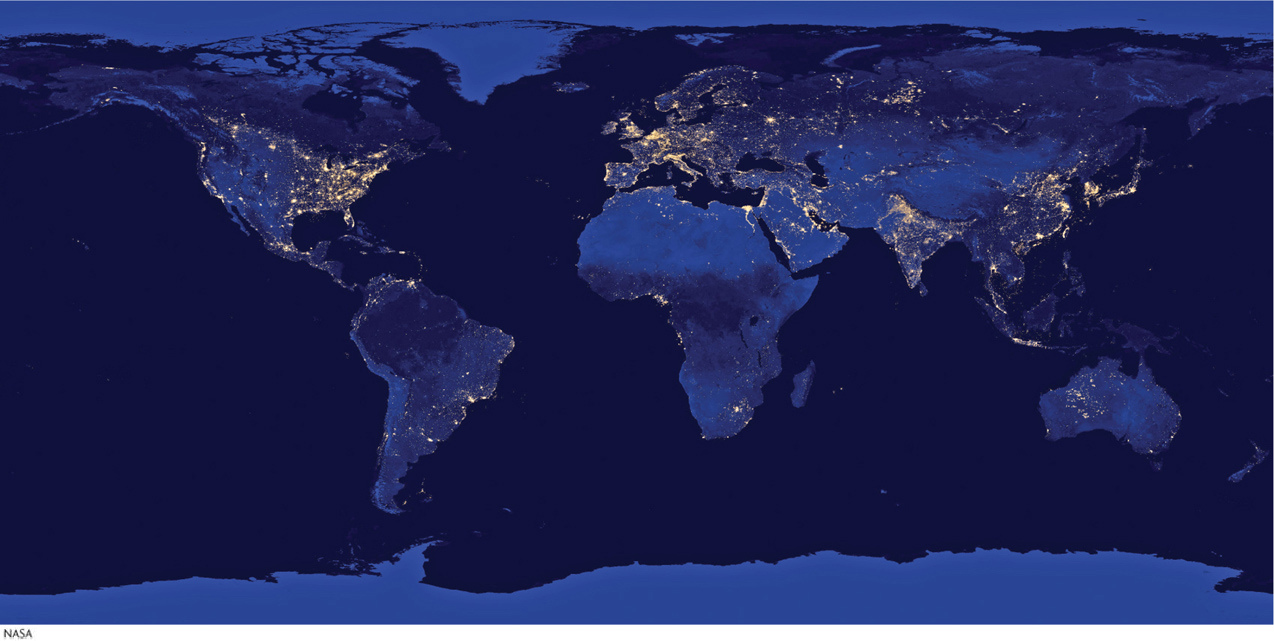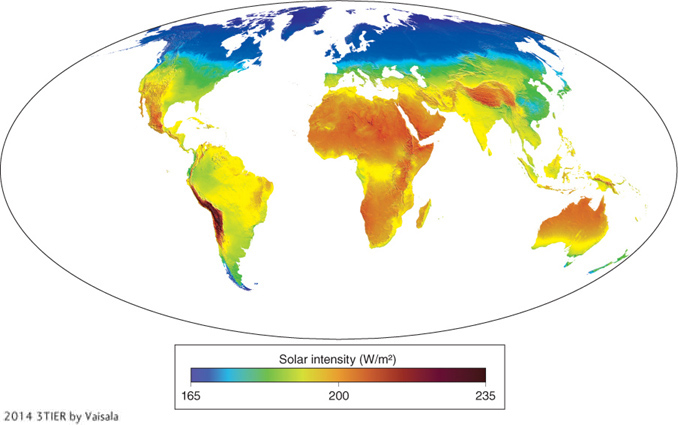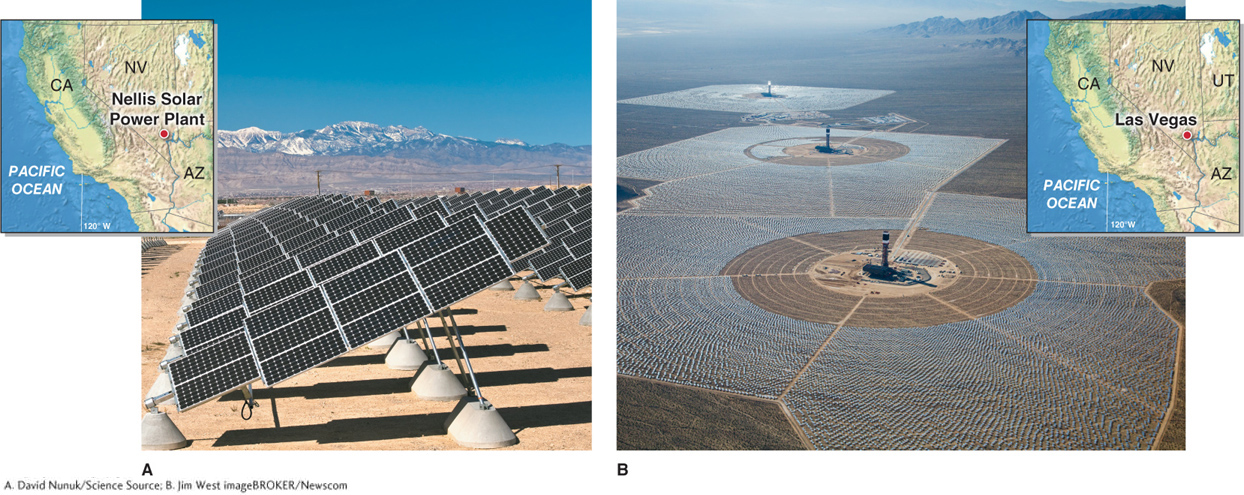2.6 The Rising Solar Economy

Assess the role of sunlight as a clean energy source.
Imagine how difficult life would be without electricity, gas stoves, or gasoline. How would we get to school or work? Use computers and cell phones? What would we eat? How would food be harvested from the field, transported to the supermarket, and kept in refrigerators? How would we manufacture items like clothes and houses?
Just about every aspect of our lives requires the use of energy. The growth and development of world economic systems and societies are driven by the consumption of energy.
Where do we currently get our energy? Mostly from fossil fuels, which have driven the world economy since the middle of the 1800s. The global economy today relies on fossil fuels for about 85% of its energy needs. But our energy sources are changing, and the coming generations, beginning with ours today, will be part of a movement away from fossil fuels to renewable energy. Renewable energy comes from sources that are not depleted when used, such as sunlight or wind. Most renewable energy sources do not release greenhouse gases into the atmosphere, so they are also referred to as carbon-
renewable energy
Energy that comes from sources that are not depleted when used, such as sunlight or wind.
Fossil fuels have served us well in many respects. Coal is widely used to generate electricity. Petroleum (oil) is used in the transportation sector. Natural gas has a wide range of uses, including heating of homes and water. But there are two serious problems with fossil fuels. First, they pollute the air, so they can jeopardize human health (see Section 1.4) and can contribute to climate change (see Section 6.3). Second, they are finite and will eventually run out—
According to the U.S. Department of Energy, the world consumed 90 million barrels of petroleum per day in 2013—
Once demand exceeds production, petroleum will become too expensive for most uses. The increased cost of petroleum will result in a much greater reliance on sources of renewable energy, such as solar energy, that are mostly or entirely carbon-
The Goal: 15 Terawatts
On average, Earth’s surface receives about 101,000 terawatts (trillion watts) of energy from the Sun. Worldwide daily power consumption is approximately 15 terawatts. But that consumption is not spread evenly across the globe (Figure 2.36).

The global energy requirement of 15 terawatts could be more than met if only a small fraction of the total amount of sunlight reaching Earth were captured. There are other sources of renewable energy besides the Sun, some of which are listed in Table 2.3.
|
RENEWABLE ENERGY TYPE* |
TOTAL THEORETICAL MAXIMUM CAPACITY (IN TERAWATTS) |
|---|---|
|
Solar |
101,000 |
|
Wind |
190 |
|
Biomass |
92 |
|
Geothermal |
42 |
|
Hydroelectric |
4.7 |
|
*Biomass energy is generated by the burning of organic material, such as agricultural wastes or plant oils. Geothermal energy comes from Earth’s internal heat. Hydroelectric energy is generated by the flow of rivers by means of turbines on dams. Data from Science August 13, 2010. |
|
Because the Sun’s energy output is so great, solar energy will certainly play a prominent role in the future energy mix. Sunlight is everywhere and seemingly free. All we have to do is collect it and use it. It sounds simple enough, except for two details: First, the radiant solar energy must be converted to electrical energy by solar panels, and solar panels take up space. Second, the energy must be transported to and stored where it is needed. We have the technology to meet these two challenges. The difficulty is doing so on a sufficiently large scale to meet global energy demand.
Unless we find a more efficient collection mechanism than solar panels, replacing even a small fraction of our global 15-
The Decentralized Approach
Rooftops provide many opportunities to capture sunlight. In an idealized decentralized solar energy production approach, every household, apartment complex, and business would generate its own electricity. If too much were generated, it could be traded or sold. One way of generating electricity from the Sun is to use photovoltaic (PV) panels. The materials in PV panels, such as silicon, absorb photons of light and release electrons, creating an electric current. In addition to PV panels, there are paints and flexible plastic films that can convert sunlight to electricity. Imagine covering our houses, buildings, and cars with these materials. Even our clothes could be made of photovoltaic cloth that could power our cell phones and other personal electronic devices.
Solar roadways are another example of the decentralized approach. There are almost 9 million km (6 million mi) of roadways in the United States and 500,000 km (300,000 mi) in Canada. Roads occupy enormous amounts of space and are often exposed to full sun. Corridors of PV panels are already being placed along highways in several U.S. states. Solar panels in parking lots are also now providing the dual purpose of shading parked cars and generating clean electricity.
One problem with decentralized solar energy production, however, is that in many cases it is not yet cost-
The Centralized Approach
In centralized solar power production, solar farms generate power at an industrial facility and send it to where it is needed. Many centralized solar facilities in the United States are located in its southwestern deserts. As Figure 2.37 shows, solar energy is more intense at lower latitudes worldwide, particularly in arid regions where cloud cover is scarce much of the year.

Although Figure 2.37 may suggest that solar energy production is effective only in deserts, this is not the case. One of the largest-
Various companies are rushing to file applications to build solar PV farms on hundreds of thousands of acres in the U.S. Southwest (Figure 2.38A). As an alternative to PV panels, concentrated solar power, or CSP, is also being developed in centralized solar industrial facilities (Figure 2.38B).

Many proposed solar facilities have met stiff opposition in the United States. Why? Because there is no “empty” land to use. What appears to be a barren desert to many can be prime habitat for many different species, such as the endangered California desert tortoise (Gopherus agassizii), which is protected by federal law. Many solar farm projects have been bogged down in litigation because they take habitat from rare or endangered plants and animals. Proposals for solar farm projects that degrade the natural habitat of threatened species rarely win these court battles.
Where, then, can we build centralized solar power facilities? Many believe the best solution to this conflict is to build on already degraded desert land (such as old parking lots) rather than in relatively pristine wilderness. Others believe we should simply not build centralized solar farms at all. Instead, we should focus our efforts and dollars on the decentralized approach to solar power development. These are problems with no easy answers. Given our need for clean energy, however, transitioning to renewable energies such as solar is only a matter of time, regardless of the hurdles.